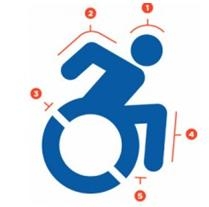Can a Sticker Change Perceptions About Disability?
http://www.care2.com/causes/can-a-sticker-change-perceptions-about-disability.html
A stick figure seated in a partial circle that suggests a wheelchair: this symbol of disability, the International Symbol of Access, was created in 1968 by a Danish graphic design student. Rehab International, a global advocacy organization for individuals with disabilities, commissioned it to standardize a way to denote that facilities were accessible to individuals with disabilities, at a time when countries used different icons. The wheelchair symbol soon became widely accepted and won the support of the United Nations; it was also written into the standards of the Americans with Disabilities Act (ADA).
What is also known as the International Wheelchair Icon has indeed become a global symbol of access. But many have felt that it is in need of an upgrade and proposed alternatives (pdf). Like the word “handicapped,” it has become outmoded over time.
Artists Redesign a Familiar Symbol
In the wheelchair icon, the figure is stiff and static; the partial circle representing the wheel of the chair dominates. As artist Sara Hendren said in the 2011 Boston Globe, “The body is synonymous with the chair.” Since the term “disability” applies to a very wide range of conditions and diagnoses — some of which, such as autism, are not readily visible — the wheelchair icon can be said to not really apply to everyone who has a disability. The wheelchair symbol, it can be said, emphasizes what a person cannot do.
In 1994, Brendan Murphy, who had come from Ireland to study art in Cincinnati, offered a redesign of the icon. As the Boston Globe says, Murphy was in part inspired by a friend of his father’s, Christy Brown, who has cerebral palsy and was the subject of the movie “My Left Foot.” Brown created a design in which the figure was active, leaning forward with an arm behind the body so she or he seemed to be pushing off the wheel. The city of San Antonio, Massachusetts’ Williams College and companies including REI and Wal-Mart have adopted Murphy’s design and New York City’s Museum of Modern Art uses a variation of it.
More recently, Hendren, who lives in Cambridge and has three children, one of whom has Down Syndrome, has also redesigned the wheelchair icon; you can see her rendition here via Accessible Icon. Like Murphy’s, Hendren’s redesign transforms the original wheelchair icon. It suggests that the person, and the chair itself, are in motion. The figure’s head is set forward, so the person is a “‘driver’ or decision maker about her mobility”; she is not passive and static, but in charge of where she is going.

Getting a new symbol adopted has not been easy, as “many worry that using anything but the original will violate” the ADA,” says the Boston Globe. But both state and federal officials who oversee disability issues say that slight variations are indeed permissible so long as an icon is recognizable as a wheelchair symbol.
A few years ago, Hendren had stickers of her icon made and placed them over the wheelchair icon on signs in Cambridge. Her goal was “not to replace the symbol but to evolve it”; the old symbol is indeed visible beneath the sticker. She was aware that placing the stickers over public signs was technically illegal. As Hendren said to the Boston Globe about her guerilla campaign:
“There’s a much bigger question to ask about who is abled and who is disabled and what we think about dependence and need. I’m just trying to start a discussion where we reevaluate our assumptions and our attitudes.’’
That is, Hendren’s new Accessible Icon urges a viewer not to see a person with a disability as someone with limits and who is passive but as independent, active and moving forward via their own power.
Brian Glenney, a philosophy professor at a small Christian college, Gordon College, and a former graffiti artist, had some of the stickers placed around his college campus (with the approval of an assistant physical plant director); friends also placed stickers over signs in Boston. Gordon College’s director of marketing communications, Cyndi McMahon, joined the project and contacted possible partners. One was Fred Doulton, a social-affairs officer at the U.N. Secretariat for the Convention on the Rights of Persons With Disabilities; he informed Victor Calise, commissioner of the New York mayor’s Office for People With Disabilities, about the new icon — and now New York City says it will start using the redesigned icon.
New York City Adapts the Accessible Icon
Calise, who was paralyzed from the chest down in a bike accident at the age of 22, describes the redesigned icon as “such a forward-moving thing.” He hopes to have the new icon placed around New York City this summer. The city of Malden in Massachusetts has also been using the redesigned icon as is in a hospital in India; Nissan has created a new taxi that incorporates Hendren’s icon (it shows a stick figure with an arm up, to hail a cab).
Wayne Sailor, a co-founder of TASH, an advocacy group for individuals with disabilities and a professor of special education at the University of Kansas, thinks the Accessible Icon “will make a splash” and “be a real trendsetter,” as he tells the Chronicle of Higher Education.
The redesigned wheelchair is just a sticker. But it, and Hendren’s and Glenney’s efforts to have it used in more and more places, show how a small change can make a big difference and even change how we perceive individuals with disabilities.
Read more : http://www.care2.com/causes/can-a-sticker-change-perceptions-about-disability.html#ixzz2WrFyVy1L
ที่มา: http://www.care2.com/causes/can-a-sticker-change-perceptions-about-disability.html
วันที่โพสต์: 5/07/2556 เวลา 04:14:16 
![]()
![]()
แสดงความคิดเห็น
รายละเอียดกระทู้
by Kristina Chew http://www.care2.com/causes/can-a-sticker-change-perceptions-about-disability.html นักกีฬาวีลแชร์เรสซิ่ง get causes updates A stick figure seated in a partial circle that suggests a wheelchair: this symbol of disability, the International Symbol of Access, was created in 1968 by a Danish graphic design student. Rehab International, a global advocacy organization for individuals with disabilities, commissioned it to standardize a way to denote that facilities were accessible to individuals with disabilities, at a time when countries used different icons. The wheelchair symbol soon became widely accepted and won the support of the United Nations; it was also written into the standards of the Americans with Disabilities Act (ADA). What is also known as the International Wheelchair Icon has indeed become a global symbol of access. But many have felt that it is in need of an upgrade and proposed alternatives (pdf). Like the word “handicapped,” it has become outmoded over time. Artists Redesign a Familiar Symbol In the wheelchair icon, the figure is stiff and static; the partial circle representing the wheel of the chair dominates. As artist Sara Hendren said in the 2011 Boston Globe, “The body is synonymous with the chair.” Since the term “disability” applies to a very wide range of conditions and diagnoses — some of which, such as autism, are not readily visible — the wheelchair icon can be said to not really apply to everyone who has a disability. The wheelchair symbol, it can be said, emphasizes what a person cannot do. In 1994, Brendan Murphy, who had come from Ireland to study art in Cincinnati, offered a redesign of the icon. As the Boston Globe says, Murphy was in part inspired by a friend of his father’s, Christy Brown, who has cerebral palsy and was the subject of the movie “My Left Foot.” Brown created a design in which the figure was active, leaning forward with an arm behind the body so she or he seemed to be pushing off the wheel. The city of San Antonio, Massachusetts’ Williams College and companies including REI and Wal-Mart have adopted Murphy’s design and New York City’s Museum of Modern Art uses a variation of it. More recently, Hendren, who lives in Cambridge and has three children, one of whom has Down Syndrome, has also redesigned the wheelchair icon; you can see her rendition here via Accessible Icon. Like Murphy’s, Hendren’s redesign transforms the original wheelchair icon. It suggests that the person, and the chair itself, are in motion. The figure’s head is set forward, so the person is a “‘driver’ or decision maker about her mobility”; she is not passive and static, but in charge of where she is going. โลโก้คนพิการนั่งรถเข็น A Challenge to Get New Icons Accepted Getting a new symbol adopted has not been easy, as “many worry that using anything but the original will violate” the ADA,” says the Boston Globe. But both state and federal officials who oversee disability issues say that slight variations are indeed permissible so long as an icon is recognizable as a wheelchair symbol. A few years ago, Hendren had stickers of her icon made and placed them over the wheelchair icon on signs in Cambridge. Her goal was “not to replace the symbol but to evolve it”; the old symbol is indeed visible beneath the sticker. She was aware that placing the stickers over public signs was technically illegal. As Hendren said to the Boston Globe about her guerilla campaign: “There’s a much bigger question to ask about who is abled and who is disabled and what we think about dependence and need. I’m just trying to start a discussion where we reevaluate our assumptions and our attitudes.’’ That is, Hendren’s new Accessible Icon urges a viewer not to see a person with a disability as someone with limits and who is passive but as independent, active and moving forward via their own power. Brian Glenney, a philosophy professor at a small Christian college, Gordon College, and a former graffiti artist, had some of the stickers placed around his college campus (with the approval of an assistant physical plant director); friends also placed stickers over signs in Boston. Gordon College’s director of marketing communications, Cyndi McMahon, joined the project and contacted possible partners. One was Fred Doulton, a social-affairs officer at the U.N. Secretariat for the Convention on the Rights of Persons With Disabilities; he informed Victor Calise, commissioner of the New York mayor’s Office for People With Disabilities, about the new icon — and now New York City says it will start using the redesigned icon. New York City Adapts the Accessible Icon Calise, who was paralyzed from the chest down in a bike accident at the age of 22, describes the redesigned icon as “such a forward-moving thing.” He hopes to have the new icon placed around New York City this summer. The city of Malden in Massachusetts has also been using the redesigned icon as is in a hospital in India; Nissan has created a new taxi that incorporates Hendren’s icon (it shows a stick figure with an arm up, to hail a cab). Wayne Sailor, a co-founder of TASH, an advocacy group for individuals with disabilities and a professor of special education at the University of Kansas, thinks the Accessible Icon “will make a splash” and “be a real trendsetter,” as he tells the Chronicle of Higher Education. The redesigned wheelchair is just a sticker. But it, and Hendren’s and Glenney’s efforts to have it used in more and more places, show how a small change can make a big difference and even change how we perceive individuals with disabilities. Read more : http://www.care2.com/causes/can-a-sticker-change-perceptions-about-disability.html#ixzz2WrFyVy1L
จัดฟอร์แม็ตข้อความและมัลติมีเดีย
รายละเอียดการใส่ ลิงค์ รูปภาพ วิดีโอ เพลง (Soundcloud)


